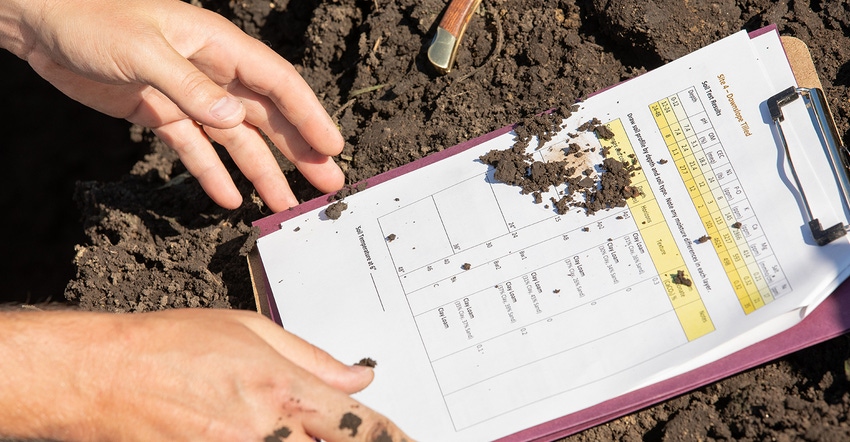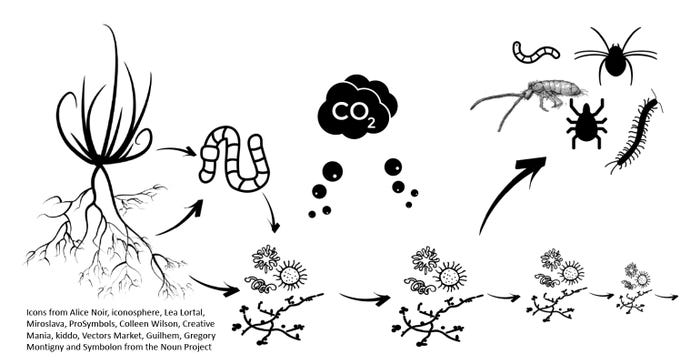January 28, 2020

The Haney soil health test, named for USDA scientist Rick Haney, includes more than a dozen different soil test values. These include standard macro- and micro-nutrients for plant consumption.
Yet what is different about the Haney test is that it also estimates nutrients for microbial consumption, focusing on how much carbon (C) and nitrogen (N) are in the soil.
These are sub-pools of the total soil organic matter (OM), like soil respiration, water-extractable C and water-extractable N. Generally, these pools are correlated with total soil organic matter, so if you have a higher percentage OM, you should have higher microbially-available OM.
 SOIL HIERARCHY: The soil food web starts with plants, which fix CO2 from the atmosphere into organic carbon compounds. Microbes and grazers, such as earthworms, eat that organic carbon and respire CO2 themselves. Other larger organisms act as predators.
SOIL HIERARCHY: The soil food web starts with plants, which fix CO2 from the atmosphere into organic carbon compounds. Microbes and grazers, such as earthworms, eat that organic carbon and respire CO2 themselves. Other larger organisms act as predators.

The Haney test is intended to pick out robust soil biological activity even if your overall OM percentage isn’t very high. However, it is an open question what “enough” biological activity is, so interpreting tests such as the Haney can be difficult.
Below are five points to keep in mind if you’re looking at Haney results or considering doing a Haney test on your soil:
1. Soil biology doesn’t stop. The Haney measures microbially-available pools of C and N, as well as microbial respiration potential in a lab incubation. These are just snapshots of your organic matter pools and fluxes. Those pools are constantly being replenished by plant root exudates and dead microbial cells. It’s liable to change rapidly. So, look for trends, not absolute values.
2. Respiration doesn’t differentiate between food source and microbial capacity. Both are good things! A high soil respiration value could be due to lots of simple C sources for microbes or a large microbial population. For example, you’ll tend to see higher values in higher organic matter soils and after fertilizer application stimulates microbial activity.
3. Haney fertilizer recommendations have not been tested and calibrated for Minnesota. Thousands of research plots have gone into University of Minnesota recommendations for fertilizer applications. There are only perhaps a few dozen test plots examining Haney fertilizer recommendations and none in Minnesota. Plus, Haney tests don’t capture the total soil nutrient pool because they only sample the top six inches.
4. Don’t bank on the N release value. This is based on an “average” four times per season when sufficient rainfall will release N. As everyone who’s farmed through the last couple of years knows, the average season is probably not relevant to many seasons.
5. Changes in soil biological tests can take a long time. Despite many claims of rapid organic matter increases, tests don’t always reflect management changes. Pay attention to plant health, water infiltration and soil structure and retention. If you’re seeing improvements in these functions, don’t worry too much about the tests.
If you’re not sure what to look for, invite a local Natural Resources Conservation Service or soil and water conservation district employee to your field. If you’re curious about your soil biology, sample every few years at the same time under the same conditions and look for trends, not absolute values. Compare to a nearby undisturbed area for the best benchmark of your soil’s potential.
For more information about “typical” Minnesota values for the Haney test, as well as its ability to make nitrogen and phosphorus fertilizer recommendations, watch the webinar below:
Cates is a University of Minnesota Extension soil health specialist.
You May Also Like




